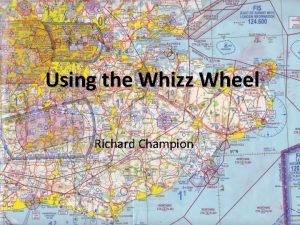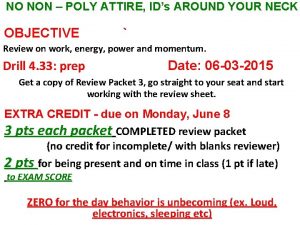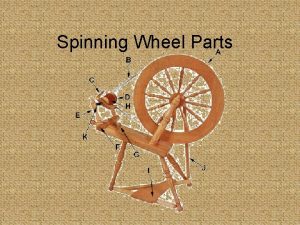Using the Whizz Wheel Richard Champion Aim Using









- Slides: 9

Using the Whizz Wheel Richard Champion

• Aim Using the Whizz Wheel – To learn how to use the whizz wheel to calculate wind adjusted headings and ground speeds. • Objective – By the end of this briefing, you should be able to calculating headings and ground speeds using both wind up and wind down methods, and also complete a wind star. • Airmanship – Accurate navigation. Avoiding airspace busts • Agenda – Calculating headings and groundspeeds using wind up method. – Preparing a wind star & calculating max drift. – Summary

Getting The Wind Metform 214 OTHER SOURCES OF F’CST WINDS AIRMET SOUTHEAST ENGLAND • FAUK 34 EGRR 020430 AIRMET AREA FORECAST, SOUTHEAST ENGLAND, VALID MAR 02/0600 Z TO 02/1500 Z. • • • MET-SITUATION: AT 06 Z AN AREA OF HIGH PRESSURE LIES TO THE N OF THE REGION, INTRODUCING A MOD NE FLOW. STRONG WIND WRNG: ISOL GUSTS 20 -25 KT, MAINLY SEA COT S. WINDS: – 1000 FT: 040/20 KT. MS 01 BECMG PS 02 BY 12 Z. – 3000 FT: 070/25 KT. PS 04. – 6000 FT: 080/25 KT. MS 02. – FREEZING LEVEL: GEN 5000 FT, BUT SUB-ZERO LYR 5002500 FT TL 12 Z. WEATHER-CONDITIONS: AT 06 Z: WHOLE REGION: GEN 15 KM WITH 0 -4/8 ST 1000 FT/1500 AND 6 -8/8 SC 1500 - 2500 FT/3000. ISOL SE FM 10 Z, 20 KM, WITH 0 -3/8 SC 2500 FT/3000. AREAS 7 KM IN HZ, WITH 6 -8/8 STSC 1000 FT/3000. OCNL, BECMG ISOL BY 10 Z, 3000 M IN BR OR DZ, WITH 4 -7/8 ST 600 FT/1500 AND 6 -8/8 SC 1500 FT/3000. WRNG: OCNL HILL FG. ISOL MOD ICE AND MOD TURB IN CLD. REVERSE ENGINEERING METARS FOR 2, 000 ft WIND • Take METAR from airfields close to route. • Add 30 degrees to wind direction • Double wind speed, then knock off 10% E. g. EGKK 140720 Z 25007 KT gives a 2000 ft wind of 280/12.

Exercise • Forecast wind at 2000 ft is 230 at 15 kts. • Your true course is 118 degrees • Your True Airspeed is 106 kts 1. What is your True Heading? 2. What is your ground speed?

Wind Up Method 1. Put wind direction under Index Mark 2. Mark wind velocity up from centre 3. Put true track under index 4. Slide wind velocity mark to TAS line (106 kt) 5. Read Ground speed under centre. 6. Read wind correction angle between centre line and wind mark Ground speed = 110 Kt Wind Correction Angle = 8° right

Wind Down Method 1. Put wind direction under Index Mark 2. Mark wind velocity down from centre 3. Slide TAS to centre 4. Set desired track under Index Mark 5. Note drift = 7° left 6. Adjust heading to allow for drift by adding 7° to 118° = 125° 7. Note new drift = 8° left 8. Adjust heading again by adding the extra 1° 9. Confirm drift still 8° 10. Note Heading under Index Mark Heading = 126° (118° + 8°) 11. Note ground speed under wind mark Ground speed = 110 Kt

Exercise 1. What is your True Heading? 118 +8 = 126° 2. What is your Compass Heading? + Variation (2° W) + deviation (from compass deviation card) 118° +8° 126° +2° 128° -1° 127°

Wind Star WCA -6 GS WCA -8 GS WCA -1 000 104 315 045 WIND 230 WCA -5 270 GS 115 TAS 94 GS 120 /15 WCA +5 090 106 GS 116 MAX DRIFT 8° WCA +1 GS 135 225 WCA +8 180 91 GS 106 WCA +6 Max Drift = GS (Wind speed x 60)/TAS 96 =(15 x 60)/ 106 = 8. 49 degrees

Summary • We have learned about: – How to estimate winds aloft – Using wind up method to calculate wind adjusted true headings and groundspeeds – Using wind down method to do the same – How to prepare a wind star
 Whizzwheel
Whizzwheel Richard iii pursuit of power
Richard iii pursuit of power Tire wheel and wheel bearing fundamentals
Tire wheel and wheel bearing fundamentals Tire wheel and wheel bearing fundamentals
Tire wheel and wheel bearing fundamentals Leads the balance wheel through the belt connection.
Leads the balance wheel through the belt connection. Care certificate privacy and dignity answers
Care certificate privacy and dignity answers Maya angelou champion of the world
Maya angelou champion of the world A project champion is
A project champion is Brutus a champion weightlifter raises
Brutus a champion weightlifter raises Nice student champion
Nice student champion
















